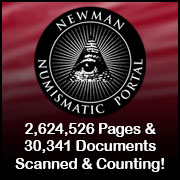
About UsThe Numismatic Bibliomania Society is a non-profit association devoted to the study and enjoyment of numismatic literature. For more information please see our web site at coinbooks.org SubscriptionsThose wishing to become new E-Sylum subscribers (or wishing to Unsubscribe) can go to the following web page link MembershipThere is a membership application available on the web site Membership Application To join, print the application and return it with your check to the address printed on the application. Print/Digital membership is $40 to addresses in the U.S., and $60 elsewhere. A digital-only membership is available for $25. For those without web access, write to: Charles Heck, Treasurer AsylumFor Asylum mailing address changes and other membership questions, contact Chuck at this email address: treasurer@coinbooks.org SubmissionsTo submit items for publication in The E-Sylum, write to the Editor at this address: whomren@gmail.com BUY THE BOOK BEFORE THE COIN |
- WAYNE'S WORDS: THE E-SYLUM SEPTEMBER 15, 2019
- SCHILB ANTIQUARIAN NUMISMATIC OFFERINGS
- NEW BOOK: EARLY DATED COINS OF EUROPE, 2ND ED.
- NEW BOOKS: RUSSIAN COIN CATALOGS
- NEW BOOK: CONNECTICUT TRADE TOKENS
- NEW BOOK: GODREFROID DEVREESE 1861-1941
- BOOK REVIEW: THE STORY OF SILVER
- REVIEW: GUIDE BOOK OF CIVIL WAR TOKENS, 3RD ED.
- EMPEROR NORTON BIOGRAPHY ON NEWMAN PORTAL
- FUTURE OF NUMISMATICS: BRETT CHARVILLE
- COLLECTING CANADIAN COINS FROM CIRCULATION
- HIGH-DENOMINATION U.S. ENCASED POSTAGE STAMPS
- NOTES FROM E-SYLUM READERS: SEPTEMBER 15, 2019
- MAROTTA ON THE THE FUTURE OF MONEY
- VIRTUAL HUMANS IN THE FUTURE OF NUMISMATICS?
- VOCABULARY TERM: COPIES AND REPLICAS
- THOMAS JAMES CLARKE (1875-1952)
- MY FIRST COIN CONVENTION BY Q. DAVID BOWERS
- MINT OFFICIAL JON CAMERON SIGNS NGC LABELS
- LITTLETON COIN COMPANY NEEDS WORKERS
- TRASK FAMILY YN SUMMER SEMINAR SCHOLARSHIP
- MEDIALIA GALLERY FALL 2019 EXHIBITS
- MEL WACKS COLLECTION OF ANCIENT JUDAEAN COINS
- NUMISMATIC NUGGETS: SEPTEMBER 15, 2019
- SIDEWALK FIND: SYRACUSE DEKADRACHM
- LOOSE CHANGE: SEPTEMBER 15, 2019
- DIRTY MONEY RESEARCH WINS IG NOBEL AWARD
- FEATURED WEB SITE: ERROR-REF.COM
Click here to access the complete archive
Click here to unsubscribe (scroll down)
To comment or submit articles, reply to whomren@gmail.com
Content presented in The E-Sylum is not necessarily researched or independently fact-checked, and views expressed do not necessarily represent those of the Numismatic Bibliomania Society.
WAYNE'S WORDS: THE E-SYLUM SEPTEMBER 15, 2019
 New subscribers this week include: Jim Ehlers, courtesy of Ron Zitterkopf. Welcome aboard! We now have 5,971 subscribers.
New subscribers this week include: Jim Ehlers, courtesy of Ron Zitterkopf. Welcome aboard! We now have 5,971 subscribers.
Thank you for reading The E-Sylum. If you enjoy it, please send me the email addresses of friends you think may enjoy it as well and I'll send them a subscription (but let me know if they are located in the European Union). Contact me at whomren@gmail.com anytime regarding your subscription, or questions, comments or suggestions about our content.
This week we open with some antiquarian numismatic literature, several new books, two reviews, and updates from the Newman Numismatic Portal.
Other topics this week include Canadian small cents, tampered-with encased postage stamps, the Future of Money and Numismatics, copies and replicas, T. James Clarke, Dave Bowers, Jon Cameron, Littleton Coin Company, Medialia Gallery, ancient Judean coins, dirty money and error coins.
To learn more about John Evelyn’s Numismata, the early dated coins of Europe, Connecticut trade tokens, medallist Godrefroid Devreese, Emperor Norton I, the origin of metallic currency, ANA Life Member No. 37, Jim Ruddy, “Suitcase” Foster, Gerald Ford Inaugural medals, and Love Token Greeting Cards, read on. Have a great week, everyone!
Wayne Homren
Editor, The E-Sylum
SCHILB ANTIQUARIAN NUMISMATIC OFFERINGS
I noticed some early numismatic literature this week in the offerings of Schilb Antiquarian of Columbia, MO. Their web site has a large number of images of each item. -Editor
Evelyn's Numismata
 John Evelyn’s ‘Numismata’ is one of the most important 17th-century books on numismatics, ancient coins, medals, collecting them, and identifying authentic and fakes.
This 1697 first edition is illustrated with engravings of medals each with inscriptions and commentary on the figures. While the title of the works refers to both numismatics,
which includes coins, the content of Evelyn’s treatise focuses primarily on medals alone.
John Evelyn’s ‘Numismata’ is one of the most important 17th-century books on numismatics, ancient coins, medals, collecting them, and identifying authentic and fakes.
This 1697 first edition is illustrated with engravings of medals each with inscriptions and commentary on the figures. While the title of the works refers to both numismatics,
which includes coins, the content of Evelyn’s treatise focuses primarily on medals alone.
This work though, takes a bizarre turn and covers more than just the study of medals. Evelyn writes about human physiognomy and the importance of the human face which appears on medals and coins. One rather odd section discusses the appearance of a beard on both a man and a woman!
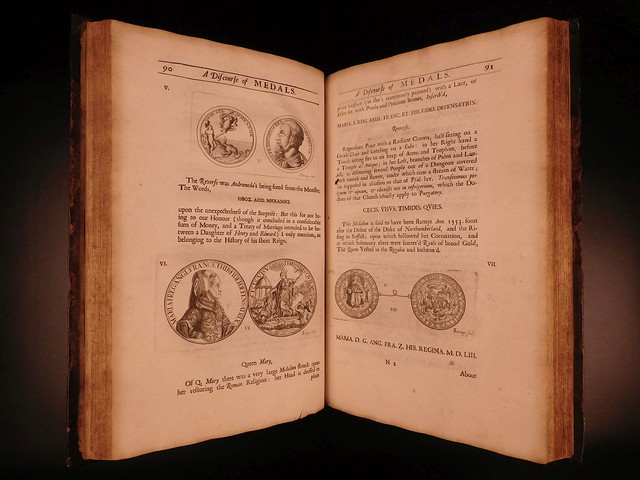
To read the complete item description, see:
1697 1st ed Evelyn Numismata Illustrated Medals
Coins Physiognomy Numismatics (https://schilbantiquarian.com/product/1697-1st-ed-evelyn-numismata-illustrated-medals-coins-physiognomy-numismatics/)
Ménestrier's History of King Louis the Great, Medals, Emblems
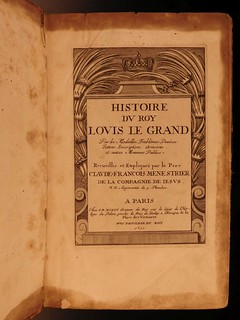 A rare history of the reign of King Louis XIV of France by Claude-François Ménestrier, an important Jesuit author. This book, ‘History of King Louis the Great,
Medals, Emblems’ was the first historical account of a modern individual. In this first-hand account, Menestrier used medals, heraldic devices, and emblems drawn from the
collection of Francis de la Chaise. Menestrier was a professor of rhetoric and cared for the organizing of festivals and ceremonies during the passage of Louis XIV to Lyon in
1685.
A rare history of the reign of King Louis XIV of France by Claude-François Ménestrier, an important Jesuit author. This book, ‘History of King Louis the Great,
Medals, Emblems’ was the first historical account of a modern individual. In this first-hand account, Menestrier used medals, heraldic devices, and emblems drawn from the
collection of Francis de la Chaise. Menestrier was a professor of rhetoric and cared for the organizing of festivals and ceremonies during the passage of Louis XIV to Lyon in
1685.
This 1691 is a pirated Dutch edition printed in Amsterdam, even though the title page states Paris. This edition includes five plates that were satirical and ‘anti-Louis’ in nature than did not appear in the Paris edition. (Saffroy). Other plates include views of Places de Victories, arms of Chevaliers of the Ordre du Saint-Esprit and more.
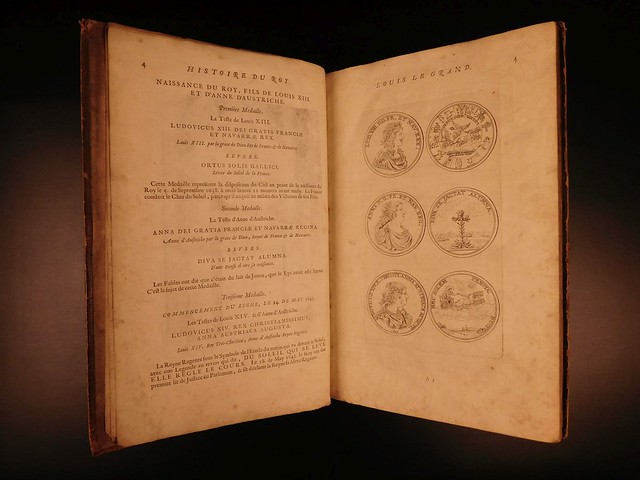
To read the complete item description, see:
1691 History of Louis XIV Illustrated Medals
Emblem Numismatics Coins Menestrier (https://schilbantiquarian.com/product/1691-history-of-louis-xiv-illustrated-medals-emblem-numismatics-coins-menestrier/)
For more works on the topic of numismatics, see:
https://schilbantiquarian.com/page/2/?s=numismatic

NEW BOOK: EARLY DATED COINS OF EUROPE, 2ND ED.
The new edition of Levinson's book on the early dated coinage of Europe will be available soon. -Editor
Second Edition of The Early Dated Coins of Europe, 1234-1500 by Robert A. Levinson
Scheduled for Release this Fall. Updated reference book now in full color and expanded to 336 pages.
 The appearance of a date on a coin is something so obvious to the layman that it is taken for granted. It will no doubt then come as a shock to discover that the custom
of placing the year of minting on coins is absent for most of coinage history. It is rather, a relatively modern phenomenon that did not begin in earnest until the end of the
Renaissance, the start of the era of what numismatists would call “modern” coinage.
The appearance of a date on a coin is something so obvious to the layman that it is taken for granted. It will no doubt then come as a shock to discover that the custom
of placing the year of minting on coins is absent for most of coinage history. It is rather, a relatively modern phenomenon that did not begin in earnest until the end of the
Renaissance, the start of the era of what numismatists would call “modern” coinage.
When the first edition of Robert A. Levinson's The Early Dated Coins of Europe, 1234-1500 made its debut in 2007, it presented for the first time a comprehensive listing, by date, region, state, ruler, and mint, of all the known types of gold, silver, and copper coins struck in medieval Europe with an Anno Domini date of 1500 or earlier. Since then, it has become the worldwide reference for such coinage. These “early dated coins,” form one of the first links between medieval and modern coinage. Anno Domini dating of coins using Latin script did not begin until the mid-13th century, and did not become prevalent in Europe until three centuries later. Separating those few coins with dates from the many struck without them at a thousand mints by hundreds of different coin-issuing authorities presented the author with a daunting task.
The first edition of this book rendered obsolete the only volume remotely comparable, the long out-of-print work by Albert Frey in 1915. Today, when an early dated coin is sold, whether in Europe or America, it is accompanied by a Levinson reference number. The revised and updated 336 page second edition is in full color throughout, with improved illustrations, including more than 200 new ones, pushing the total to over 1,200. More than 125 new coin types and subtypes have been added, and there are over 500 updates to catalog descriptions.
The book covers the eight distinct regions in which dated coins were issued: Germany, Southern Netherlands (now Belgium), Northern Netherlands (now the Netherlands), Hapsburg lands, Switzerland, Scandinavia, Italy, and France and organizes the known pre-1501 Anno Domini dated coins chronologically within each region. There is for each of the coins listed, its full legend, description, ruler's name, bibliographic references, weight, and rarity. Prices for each coin are given in very fine and extremely fine condition.
The large format, hard bound book is in four parts: The first is a lengthy history of early dated coinage, including discussions of the types, metallurgy, classifications, etc. The second part is the 215 page catalog of coinage, divided into the eight regions. The third part is a listing, again by region, of all the states issuing early dated coinage, with a history of each state’s coinage and a cross-reference to all the coins listed in the catalog. The fourth part contains eight appendices with alphabetical listings, translations of legends, a photographic glossary of coin types, a listing of early dated coinage using Islamic script, and other useful information. These glossaries and appendices are invaluable not only to collectors of “early dated coins,” but also to anyone needing a quick reference on medieval coin-issuing cities, states, and mints, identifying their basic designs, or reading their sometimes complicated legends. Every numismatist will find the annotated bibliography a vital resource.
The Early Dated Coins of Europe, 1234-1500 (ISBN 978-0-87184-601-3) is destined to be a standard reference for years to come. Sample pages from it and more information may be found at, www.coin-currency.com . It will be available in October from coin dealers, and by special order from book stores. It is not available from Amazon. In North America, copies may also be ordered on the publisher's website www.coin-currency.com or by mail from Coin & Currency Institute, P.O. Box 399, Williston, VT 05495 for $88.95 including postage and handling. Major credit cards are accepted. Call toll- free 1-800-421-1866, fax (802) 536-4787 or e-mail: mail@coin-currency.com . There are also e-book and Kindle versions for $39.99 (ISBN 978-0-87184-010-3). Collectors and dealers outside North America should contact the book's international distributors:
Germany, Austria, Switzerland--Fritz Rudolf Künker GmbH & Co. KG. service@kuenker.de
Belgium, Netherlands, Luxembourg--Schulman b.v. info@schulman.nl
France, Italy, Spain, Portugal--Editions Victor Gadoury, Monaco. contact@gadoury.com
Asia--Daruma International Galleries. info@darumacoins.co.jp
Australia, New Zealand-- Renniks Publications--info@renniks.com
For more information, or to order, see: The Early Dated Coins of Europe, 1234-1500 (http://www.coin-currency.com/page65.html)

NEW BOOKS: RUSSIAN COIN CATALOGS
We recently discussed the German-language world coin catalogs (called the AKS catalogs, named for authors Arnold, Küthmann and Steinhilber). Readers are encouraged to pass along notice of other useful catalogs published around the world in any language. Here are some Russian publications I encountered recently on eBay that we haven't discussed before. Can anyone tell us more about the Wolmar and Coins Moscow publications? -Editor


To order, see:
Catalog of Soviet Union and Russian coins 1918-2018
Gold Silver Coin Catalogue (https://www.ebay.com/itm/Catalog-of-Soviet-Union-and-Russian-coins-1918-2018-Gold-Silver-Coin-Catalogue/254334480093)
Coins catalog of the USSR and Russia 1918-2020, ed.
12 NEW With prices Catalogue (https://www.ebay.com/itm/Coins-catalog-of-the-USSR-and-Russia-1918-2020-ed-12-NEW-With-prices-Catalogue/254336187478)


To order, see:
Wolmar 14/01.2016 Catalogue of Russian coins&tokens 1700-1917, Russian language (https://www.ebay.com/i/223624767016)
Wolmar 15th/06.2016 Catalogue of Russian coins&tokens 1700-1917,Russian language (https://www.ebay.com/i/223508693347)

NEW BOOK: CONNECTICUT TRADE TOKENS
Author Manuel Ayala forwarded this information on his new book on Connecticut trade tokens. Thanks, and congratulations! -Editor
 This book represents the first trade tokens catalog for the state of Connecticut. When I initially started this project I was surprised to discover that most of the
states within New England region do not have trade token catalogs, whereas larger states to the west and south of us do. In my mind, this catalog had to be more than just a
listing of all known tokens for the state – it had to encompass Connecticut’s history, its businesses and its people.
This book represents the first trade tokens catalog for the state of Connecticut. When I initially started this project I was surprised to discover that most of the
states within New England region do not have trade token catalogs, whereas larger states to the west and south of us do. In my mind, this catalog had to be more than just a
listing of all known tokens for the state – it had to encompass Connecticut’s history, its businesses and its people.
As I added tokens to this body of work, I also included as much information as I could such as the business’ name, its proprietor, the town and address where the business resided, and the years of operation. In doing so, I often found interesting facts about the owner or the town many of which I have documented throughout this work. It is my hope to show the expansive use of tokens in all types of businesses, their place in history and the communities that put them into circulation. My research introduced me to many people willing to share their knowledge and experiences, and on more than one occasion, I found people giving me a verbal walking tour of their town, streets and the owners whose establishments resided on them.
The catalog is 712 pages and it is fully illustrated covering tokens from mid-1800’s to the present. It has over 6,000 tokens or related exonumia identified. Each of the tokens described in this catalog are accompanied, when available, with color images of both the obverse and reverse sides. Each token is assigned a unique identification number and an estimated value scale. The tokens are fully described including ornamentation and minter’s name. All known varieties are depicted. Their composition, shape, border and edge details are fully described. In addition, there is a reference line that lists how many of the specific tokens I have seen and where I encountered them, such as other catalogs or online sites. Any historical information that was obtained is listed in the notes section found below the description.
Additionally, this catalog includes modern plastic tokens (1970’s), wooden nickels, wooden flats, advertisement mirrors, Mason tokens and encased coins. I have also added a section of identification tags which represent many of the industries in the state. Last but not least, I have included a mavericks section that identifies tokens that I have come across in my research that I could not attribute to Connecticut with any great assurance. The catalog is fully indexed which will make it easier for users to find those tokens listed.
About the Author:
Manuel A. Ayala, like many other collectors today, started collecting world coins at a young age – in his case 10 years old. He continued collecting world coins and eventually
‘odd’ and ‘curious’ currency until he graduated from Wesleyan University in 1984. Shortly, after graduating, his interests evolved into collecting tokens from his native home –
Puerto Rico, which, unfortunately, were difficult acquire due to their scarcity and the exorbitant prices they demanded. He once again expanded his interests to Central and Latin
American tokens. In 2007, after it was suggested to him that he write a catalog on Connecticut tokens, he proceeded to do some initial research on the subject. Now, after 12
years, the first catalog of Connecticut tokens is officially done and available. He is an active member of both NTCA and TAMS. You can contact the author via email at connecticuttokens@gmail.com.
Book Details:
Glossy hardcover
712 pages
8 ½” x 11”
Color on #80 glossy paper
Price: $110.00 (includes shipping, tracking and insurance)
Please send checks or money orders to: Manuel A. Ayala
116 Putnam Avenue
Hamden, CT 06517
NEW BOOK: GODREFROID DEVREESE 1861-1941
Medal dealer Hedley Betts forwarded this information about a new book on Belgian medallist Godrefroid Devreese. Thanks! Here are the basics. -Editor
 POELS, Andre; VANDAMME, Luc; and VAN DRIESSCHE, Jacqueline. Godrefroid Devreese 1861-1941. Belgium, 2019. Limited edition of 110 copies. 724 pages. 8 1/2 inches x
12 inches. Hard cover. $135 ------ Godfroid Devreese, the prominent Belgium medallist, was inspired by the revival in medallic art that occurred in France during the late 19th
century. He was particularly influenced by Ponscarme, Oudine, Roty and Chaplain. He created an extensive oeuvre of medallic works over his long career that extended into his late
years.
POELS, Andre; VANDAMME, Luc; and VAN DRIESSCHE, Jacqueline. Godrefroid Devreese 1861-1941. Belgium, 2019. Limited edition of 110 copies. 724 pages. 8 1/2 inches x
12 inches. Hard cover. $135 ------ Godfroid Devreese, the prominent Belgium medallist, was inspired by the revival in medallic art that occurred in France during the late 19th
century. He was particularly influenced by Ponscarme, Oudine, Roty and Chaplain. He created an extensive oeuvre of medallic works over his long career that extended into his late
years.
This book has an introduction in French and Dutch. It catalogues and illustrates Devreese's works with its main text in Dutch. Descriptions of medals identify the manufacturer and, in some cases, the reported mintages of medals. It has an extensive bibliography. Most illustrations are in black and white with a few in color.
Hedley Betts adds:
I have just received a small supply of the book, which may be of interest to readers of The E-Sylum. I have listed it on my website and it is available at $135, including shipping within the United States.
Devreese is an important medallist, whose work is frequently overlooked by collectors, who tend to focus more on French medals of his period. There was an exhibition of his work in the early 1990s, but the accompanying catalogue was a photocopy of a typewritten manuscript with very poor quality illustrations. This is an infinitely superior work in terms of quality and scholarship and should definitely be in the library of any serious collector of Medallic art.
For more information, or to order, see:
POELS, A; VANDAMME, L; & VAN DRIESSCHE. Godefroid Devreese
1861-1941 (https://www.mcssl.com/store/8596432/poels-a-vandamme-l-van-driessche-godefroid-devreese-1861-1941)

BOOK REVIEW: THE STORY OF SILVER
Lou Golino published a CoinWeek article September 12, 2019 on the role of silver in American history, politics and finance. It's based mainly on the new book on the topic by William Silber. Here's an excerpt - please see the complete article online. -Editor
 It was primarily due to the author’s interest in the fascinating story of how the Hunt brothers cornered the market in silver in the late 1970s, driving its price up to
$50 an ounce by January 1, 1980 (which was also due to world events such as the Iranian Revolution) that finance expert William Silber wrote his deeply researched and beautifully
written The Story of Silver: How the White Metal Shaped America and the Modern World.
It was primarily due to the author’s interest in the fascinating story of how the Hunt brothers cornered the market in silver in the late 1970s, driving its price up to
$50 an ounce by January 1, 1980 (which was also due to world events such as the Iranian Revolution) that finance expert William Silber wrote his deeply researched and beautifully
written The Story of Silver: How the White Metal Shaped America and the Modern World.
Silber was, for 30 years, a finance and economics professor at New York University’s Stern School of Business. He has served as a consultant to many companies, as well as the President’s Council of Economic Advisers, and is the author of many previous volumes. His well-received new book published earlier this year helps educate the reader about many of the key concepts regarding silver’s role in the U.S. monetary system while also providing an entertaining account of the key personalities that have shaped that history. Some reviewers have compared it to a John Grisham thriller.
Silber’s focus is on how silver went from soft money to hard asset and how powerful individuals — either acting on their own behalf or for the silver industry — have manipulated silver’s role in our monetary system and its price. Many readers probably have heard about how the mining industry lobbied for passage of legislation that resulted in the striking of the Morgan dollar from 1878 to 1904 and in its return in 1921 following extensive melting. But many may not realize how fundamental this dynamic has been to the role of silver in our monetary system and may not be familiar with the repeated cycles of unintended consequences from domestic support for the silver industry on our economy and even on our foreign policy and major world events.
Silber (whose last name serendipitously means “silver” in German) goes back to the founding of the American nation to understand silver’s role. Alexander Hamilton, the first Secretary of the Treasury, favored a bimetal monetary system based on silver and gold coinage, which led to the ratio of 15 to 1 between the two metals established under the 1792 Coinage Act used for many years afterward.
To read the complete article, see:
The Coin Analyst: Silver’s Important Role in
American History, Politics and Finance (https://coinweek.com/bullion-report/the-coin-analyst-silvers-important-role-in-american-history-politics-and-finance/)
To read the earlier E-Sylum articles, see:
NEW BOOK: THE STORY OF SILVER (https://www.coinbooks.org/v22/esylum_v22n08a06.html)
NEW BOOK: THE STORY OF SILVER (https://www.coinbooks.org/v22/esylum_v22n19a05.html)

REVIEW: GUIDE BOOK OF CIVIL WAR TOKENS, 3RD ED.
Jack Topping of JET Numismatics recently reviewed Dave Bowers' book A Guide Book of Civil War Tokens. With permission, here it is. Thanks! -Editor
 Ask any numismatist about the history of the pieces in their collection. Some will respond will facts, dates, impressive knowledge and stories. Others may not care as
much, as long as the investment is secure. The idea of living vicariously through little pieces of metal is all too real with U.S. Civil War Token collectors. To imagine the
places the token has been, the people that held them, and their stories, is all part of the experience with Civil War Tokens. For such a specific field in an even smaller era,
where does one begin to study the fascinating history of Civil War Tokens? That’s where expert numismatist Q. David Bowers comes in with the new 3rd Edition of his book, “A Guide
Book of Civil War Tokens”.
Ask any numismatist about the history of the pieces in their collection. Some will respond will facts, dates, impressive knowledge and stories. Others may not care as
much, as long as the investment is secure. The idea of living vicariously through little pieces of metal is all too real with U.S. Civil War Token collectors. To imagine the
places the token has been, the people that held them, and their stories, is all part of the experience with Civil War Tokens. For such a specific field in an even smaller era,
where does one begin to study the fascinating history of Civil War Tokens? That’s where expert numismatist Q. David Bowers comes in with the new 3rd Edition of his book, “A Guide
Book of Civil War Tokens”.
Like all numismatists, daydreaming about the history of their collection is omnipresent. The difference, and unique nature of Civil War tokens, is that they came to prominence as a currency substitute in the most divisive period in American history. These tokens, as opposed to regular government issued coinage, were made by shopkeepers, merchants, and other small business owners as a means to continue to provide for their families and communities throughout the Civil War.
Chock full of information, the 512 page book is better described as the ultimate textbook for the Civil War Token collector. The information, combined with thousands of photos of individual tokens, has a certain similarity to R. S. Yeoman’s A Guide Book of United States Coins, first published in 1947 (another Whitman “must have” publication). This makes glancing over pages upon pages of information easy to read and understand.
JET Quick Facts:
Cover: Paperback
Pages: 512
ISBN-13: 978-0794846466
Publisher: Whitman Publishing, LLC
Edition: 3rd
The book begins with a Foreword by John Ostendorf, a Publisher’s Preface by Dennis Tucker, and a Reminiscence by Dr. George Fuld, all three of which provide valuable insight to the book, personal experiences with Civil War Tokens, and the importance each token had on an American society dampened with war. Chapter 1 begins as a reference guide for the reference guide. Bowers uses this space to diverge information used in the book to the reader, including definitions, codes used to delineate the metallic composition of the tokens, and Dr. George Fuld’s rarity scale, among other facts.
In Chapter 2, Bowers first discusses the history of the era before anything else. To emphasize the importance of this section, Bowers spends three of the first four chapters on historical context alone. Not only does Bowers give an overview of the reasoning behind the existence of the tokens, he goes a step further and includes information about how they’re collected throughout the war, as seen in Chapter 4, “Civil War Tokens and the History of Collecting Them”.


As the book enters Chapter 5, “Aspects of Collecting Civil War Tokens”, Bowers initially addresses the topic of how to get started and where to buy them (Bowers aptly refers to this section as “The Marketplace”). Bowers then proceeds to give a quick guide on the grading standards of the tokens, determining the value of the tokens, factors that affect values, giving advice on choosing the right dealer or seller, and much more.
As seen here on page 70, Bowers discusses how to enjoy your collection after amassing it. Bowers first makes a jocular comment towards modern U.S. collectors, saying, “Pity the collector of 20th-century Federal coins that differ little except for date and mintmark”. While the comment was made in jest, Bowers highlights the interesting—and creative—nature of Civil War Tokens, their designs, purpose, and value in different shops across the country. After page 70, Chapter 5 continues to address the different factors of collecting, and Bowers shares stories that influence the way one could collect Civil War Tokens (such as “The Curious Dies of the Family Gies”).
Chapter 6, “Patriotic Civil War Tokens”, begins with a praise towards Dr. George Fuld, the same gentleman who wrote the fascinating Reminiscence and developed the rarity scale in Chapter 1. This chapter uses his work extensively in the reference to dies and their obverse/reverse combinations. This is explained in Chapter 1 with an explanation of the Fuld numbers of patriotic tokens. As seen here on page 154, the layout is crisp, even, with a detailed color photo for each entry. It’s listed in top-down order with the same format for each entry: the title in bold, a short description of the design (either with or without a date listed), followed by store card information such as name of the shopkeep or location (if applicable), the obverse and reverse die numbers that can be referenced in this book, the Fuld numbers (i.e. “70/281a”) then finally a grade range (i.e. “EF-AU” for Extremely Fine to Almost or About Uncirculated, respectively) and present day values in United States Dollars.
The book continues to list over 500 different patriotic dies, with crisp and detailed images in full color, with the same layout as the examples in the image above. The dies, their pictures, specific details and information make up the majority of Chapter 6 and well over two hundred pages.
As the book enters Chapter 7, “Civil War Store Cards”, Bowers focuses on the specific tokens that bear the same name as the chapter title. Bowers, in the first sentence, explains exactly what a store card is on page 200, saying, “Civil War store cards comprise the class of tokens with at least one, sometimes both dies bearing the name of a specific merchant, product, service or other commercial aspect.” With that, Bowers introduces the chapter with vivid stories about certain store cards and a specific history on them, including a section about the collectability of store cards during the war, similar to the introduction in Chapter 4.
Chapter 7, like Chapter 6, acts as a complete reference for the tokens. First, there’s a section about token dies both used as patriotic tokens and store card tokens, with Fuld numbers listed for each entry. Nearly fifty pages later, the listings for each store card is organized by state. As seen here on page 255, these store card tokens are listed alphabetically first by state, and then by surname. Although some entries do not have a corresponding photo, each entry meets the “standard” Q. David Bowers set for himself in previous chapters, by including detailed information for each entry.
Although the chapters end with Chapter 7, Bowers still continues to provide expert information in Appendix A through F. Like a crowd shouting “Encore!”, Bowers provides even more information in these appendices, such as a detailed listing of engravers in that era, encased postage stamps for use as currency, Sutler tokens, and much more. The final pages of the book includes detailed notes, a biography on Q. David Bowers, and a useful index.
Final Thoughts
Q. David Bowers’ “A Guide Book of Civil War Tokens” is clearly a book for every historically driven numismatist. Numismatists of all ages and interests will be pleased to know that this book is not just a reference to the dies of patriotic and store card Civil War Tokens, it’s an entire history of the same, with detailed information spanning multiple chapters. It’s truly a book one could sit down and start to read, with or without Civil War Tokens in hand. I’ve learned more about Civil War Tokens after reading through this book than any other online articles or references I’ve seen mentioning Civil War Tokens. It’s another gem in Whitman’s Bowers Series and I look forward to collecting these tokens, thanks to the inspiration I’ve received entirely from this book. All in all, “A Guide Book of Civil War Tokens” is an information rich “textbook” for any numismatist, and it holds a valuable place on my bookshelf.
You can find the book here on the Whitman Publishing website.
Many thanks to Mr. Q. David Bowers, Mr. Dennis Tucker, Ms. Dawn Burbank and the entire Whitman Publishing team for their support.
To read the complete article, see:
JET Reviews #001: A Guide Book of Civil War Tokens by Q. David
Bowers (https://jetnumismatics.com/2019/09/13/jet-reviews-001-a-guide-book-of-civil-war-tokens-by-q-david-bowers/)
To read an earlier E-Sylum article, see: NEW BOOK: GUIDE BOOK OF CIVIL WAR TOKENS, 3RD ED. (https://www.coinbooks.org/v21/esylum_v21n32a04.html)

EMPEROR NORTON BIOGRAPHY ON NEWMAN PORTAL
The latest addition to the Newman Numismatic Portal is Dressler’s biography of Emperor Norton. Project Coordinator Len Augsburger provided the following report. Thanks. -Editor
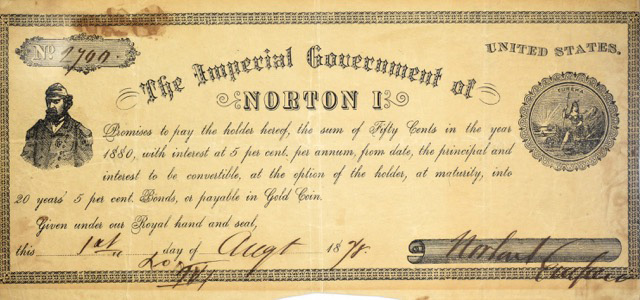
Recently added to Newman Portal is Albert Dressler’s biography of “Emperor Norton,” the colorful self-proclaimed California king, who issued a number of 19th century bonds or scrip in the name of “The Imperial Government of Norton I.” Joshua Abraham Norton (1818-1880) was born in England, and came to San Francisco in 1849. Norton was unsuccessful in business but apparently a compelling personality, one that might have been more richly rewarded in today’s culture, an environment more willing to support the eccentric celebrity. He paraded about San Francisco in full regalia and issued various and sundry edicts abolishing the U.S. Constitution, demanding that church leaders officially recognize him as “Empower,” etc. His scrip was accepted in local restaurants, akin to the modern artist J.S.G. Boggs, whose stylized adaptations of U.S. money were originally passed as “money.” Today both Norton and Boggs notes are highly collectible and usually worth much more than face value.
Image: Emperor Norton 50-cent note from Kagin’s September 2018 sale, lot 2001, realized $13,600.
Link to Emperor Norton of United States:
https://archive.org/details/emperornorton1927dres
FUTURE OF NUMISMATICS: BRETT CHARVILLE
These are selections from the David Lisot Video Library that feature news and personalities from the world of coin collecting. David has been attending coin conventions since
1972 and began videotaping in 1985. The Newman Numismatic Portal now lists all David’s videos on their website at:
https://nnp.wustl.edu/library/multimediadetail/522852
Here's one from the ANA Future of Numismatics Symposium. -Editor
 Future of Numismatics Symposium: Brett Charville
Future of Numismatics Symposium: Brett Charville
Brett Charville, President, Professional Coin Grading Service
An excerpt of the video is available for viewing on the Coin Television YouTube Channel at:
https://youtu.be/H1wiugNlqos
Donn Pearlman, Moderator, David Lisot, Video Producer, CoinTelevision.com.
At the 2019 World’s Fair of Money the American Numismatic Association asked some of the coin industry’s most influential leaders about what they believe is in store for the future of the hobby. Hear these titans of numismatics share what they believe the future holds.
THE BOOK BAZARRE
COLLECTING CANADIAN COINS FROM CIRCULATION
Vic Mason of Mamaroneck, NY submitted this piece about collecting Canadian coins inspired by earlier E-Sylum articles. Thanks! I added images found on the site of Federal Coin Exchange of Pottstown, PA. -Editor
 I very much enjoyed reading about John S. Queen and his interest in Canadian coins. The article by Tom Mulvaney brought back fond memories of my childhood interest in
collecting Canadian coins while growing up in the early 1950s in Detroit, just across the Detroit River from Windsor, Ontario. In those years, the American and Canadian currencies
enjoyed parity, so it was not uncommon for Americans in the border states to find Canadian coins in their pocket change, especially small cents dating from the early 1920s. I also
saved from change every Canadian nickel, dime and quarter I found, but those were generally much scarcer by the 1950s.
I very much enjoyed reading about John S. Queen and his interest in Canadian coins. The article by Tom Mulvaney brought back fond memories of my childhood interest in
collecting Canadian coins while growing up in the early 1950s in Detroit, just across the Detroit River from Windsor, Ontario. In those years, the American and Canadian currencies
enjoyed parity, so it was not uncommon for Americans in the border states to find Canadian coins in their pocket change, especially small cents dating from the early 1920s. I also
saved from change every Canadian nickel, dime and quarter I found, but those were generally much scarcer by the 1950s.
After 1955, my family was living in West Germany, where my dad was stationed as a career United States Army officer, and where we were using military scrip in those years (1955-57). But I never realized that military scrip might itself one day become a numismatic collectible. Anyway, girls, sports and school were increasingly taking precedence over collecting interests. Between 1955 and the early 1990s, I spent many years living and traveling in Europe, East Asia and the Middle East but never “got the bug” to collect foreign money in a way comparable to my interest in American and Canadian coins from my youth.

Mr. Mulvaney’s article caused me to pull out my old childhood blue book entitled: “Canadian Small Cent Collection: 1920 to Date.” The early 1920s were a time when a number of Canadian cents had quite small mintages, compared with those for American cents, so it was always a thrill to receive those scarce coins in change. For example, the Canadian cents of 1922, 1923, 1924 and 1925 each had a mintage of around one million, so they were never easily found in circulation.
This week, in checking my Canadian small cent collection for the first time in decades, I’m pleased to see I was able to find every date between 1920 and the mid-1950s. The only cents missing are the 1929 “high 9” variety (not known in the 1950s), and the uncollectible 1936 dot cent, produced that year to mark the change of British monarchs. The online price guide for Canadian coins shows that the four small cents of 1922, 1923, 1924 and 1925 have all appreciated markedly since I found mine so long ago.
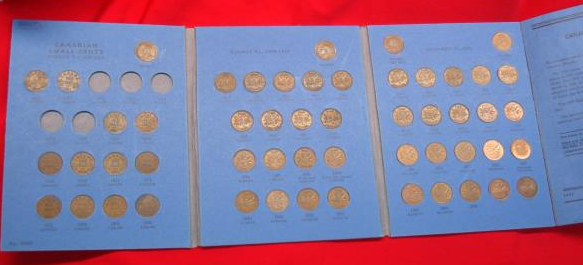
The other main part of my tiny Canadian coin collection consists of five old dimes: three with Queen Victoria on the obverse (1890H, 1896 and 1898), one with King Edward VII (1907), and one with King George V (1929). In studying the dimes from these decades, it is fascinating now to learn how many design varieties there were and how valuable some of the rarest ones have become – a fact well worth the attention of American collectors who have never thought to focus on Canadian coinage.
My dimes aren’t among the most valuable dates or varieties, but the three Queen Victoria dimes all have mintages well under one million. Due to the “E-Sylum” articles about John S. Queen, I am now seriously considering sending the scarcest of my Canadian cents and dimes to a third-party grading service. Many thanks to Canada’s coin dealers and clubs for providing so much detailed and illustrated information online about those differences.
I've got one of those Canadian cent albums, too. Mine were pulled out of circulation in the Pittsburgh, PA area, supplemented by occasional purchases at local coin shows. I'll have to take a new look at what I've got sometime. -Editor
Album images at Federal COIn Exchange:
CANADA SMALL CENT SET 1920 – 1972 > 49 DIFFERENT DATES WITH
NICE FOLDER (http://www.federalcoinexchange.com/canada-small-cent-set-1920-1972-49-different-dates-with-nice-folder/)
To read the earlier E-Sylum articles, see:
NOTES FROM E-SYLUM READERS: SEPTEMBER 1, 2019 : John S. Queen (1922-2019)
(https://www.coinbooks.org/v22/esylum_v22n35a13.html)
NOTES FROM E-SYLUM READERS: SEPTEMBER 8, 2019 : More on John Queen
(https://www.coinbooks.org/v22/esylum_v22n36a10.html)

HIGH-DENOMINATION U.S. ENCASED POSTAGE STAMPS
Paul Montz of Stephen Album Rare Coins writes:
While researching a book project, I came upon the Volume 10, number 5 issue of The E-Sylum of February 4, 2007. There is an article in that issue that deals with the substituting of stamps in encased postage. In the article, John J. Ford was quoted at the 1991 ANA Convention saying “Go ahead and buy these ‘rarities’ for an arm and a leg if you want a complete denomination set, but don’t delude yourself; all the higher denominations are concoctions.” It is interesting to note that on the sale of his Encased Postage collection in 2004 by Stack’s, all denominations were represented and there was no mention of “concoctions.” Just sayin’...
As someone who specialized in these, I can state that it is certainly possible to open one of the cases and replace it with a higher-denomination stamp. But it's also very hard to reclose the case without leaving at least some evidence of tampering. As noted in the article I once purchased and then returned a 12-cent EPS after further inspection gave me doubts.
Ford was quite knowledgeable and probably the world's expert on these; I learned some things from him. He would be very unlikely to be fooled. He also had at his disposal the vast old-time encased postage collection of William Dunham. This gave him a solid reference for comparison against any new high-denomination pieces that came his way. Originals are rare, it's true - but Ford owned many of them. So it's not necessarily inconsistent for him to say that most or all of the ones on the market at the time are suspect; it's also fair to say that if any high-denomination pieces are genuine, they would be far more likely to reside in an old-time collection like Ford's.
To confirm my thoughts I reached out to Michael Hodder and Dave Bowers of Stack's Bowers, authors of the 1989 work The Standard Catalogue of Encased Postage Stamps. Hodder catalogued the Ford sale for Stack's. -Editor
Dave Bowers writes:
 [One] learning experience ... was an encased postage stamp of the rare 24-cent denomination. I purchased it from a dealer for what I thought was a very reasonable price.
I had never owned a 24-cent variety before, and this was very exciting. I hastened to offer it to John J. Ford, Jr., who often bought unusual things from me. John viewed it with
suspicion, and suggested that it was a fake. He went so far as to say that he would like to pry it open and examine the inside, and if it proved to be genuine he would buy it from
me at a profit. However, he was sure it was no good. The back and front were parted, and out came the stamp, which had the Scott catalog number written in pencil on the back!
[One] learning experience ... was an encased postage stamp of the rare 24-cent denomination. I purchased it from a dealer for what I thought was a very reasonable price.
I had never owned a 24-cent variety before, and this was very exciting. I hastened to offer it to John J. Ford, Jr., who often bought unusual things from me. John viewed it with
suspicion, and suggested that it was a fake. He went so far as to say that he would like to pry it open and examine the inside, and if it proved to be genuine he would buy it from
me at a profit. However, he was sure it was no good. The back and front were parted, and out came the stamp, which had the Scott catalog number written in pencil on the back!
Mike Hodder writes:
Yes, you're being fair to the hobby, which is the important part, and to Ford, which in this case is incidental. Ford's comments were intemperate but he often expressed himself that way when he felt he was pressed. Remember, there was a controversy raging at the time about the issue of stamp substitution and he had taken a hard stand on one side of it. It's always easy to kick a guy who can't kick back. Just sayin.
For illustration I've added an image of a 24-Cent Hunt & Nash piece from Early American Auctions. It is one of four known, with two others sold in the 2004 Ford sale. -Editor
To read the earlier E-Sylum article, see:
ON SUBSTITUTING STAMPS IN ENCASED POSTAGE (https://www.coinbooks.org/esylum_v10n05a19.html)

NOTES FROM E-SYLUM READERS: SEPTEMBER 15, 2019
"G. Traebing" Token Still A Mystery
Bill Miller writes:
 Thanks to all for your help so far. I have access to the St. Louis, MO city directories and have most of the directory information for when the three people were in
business & where. If I can find the 1866 auction catalog reference to the Traebing token I can make a better case for when the tokens were made & used.
Thanks to all for your help so far. I have access to the St. Louis, MO city directories and have most of the directory information for when the three people were in
business & where. If I can find the 1866 auction catalog reference to the Traebing token I can make a better case for when the tokens were made & used.
The earliest auction catalog mention is the 1876 Centennial auction catalog (can be found on the Newman Numismatic Portal), but that only tells me that the tokens were issued pre-1876. A firm 1866 date would give me a nexus for establishing a better idea of when they were first used.
I believe they are Civil War era tokens (as opposed to Civil War tokens), but the 1866 catalog that Steve Tanenbaum mentioned to me is the key.
To read the earlier E-Sylum articles, see:
"G. TRAEBING" TOKEN ASSISTANCE SOUGHT (https://www.coinbooks.org/v22/esylum_v22n35a11.html)
NOTES FROM E-SYLUM READERS: SEPTEMBER 8, 2019 : More on the "G. Traebing" Token
(https://www.coinbooks.org/v22/esylum_v22n36a10.html)
How Many Hands Touch a Dollar Bill?
Last week I wondered about the number of hands a typical dollar bill passes through in its lifespan, citing the 800 number Tom Sheehan mentioned. -Editor
JP Koning writes:
I haven't been able to find an official estimate, but think 800 is a reasonable number. According to the Federal Reserve, the average dollar bill lasts about 7.9 years, so if you assume it gets used once every one or two days, that gets you in the ballpark.
Mind you, a typical dollar bill will often be collected by cash-in-transit companies and cycled through machines that sort for fitness. If it is is still in good condition, it'll be recirculated. But if it has a marking on it, the machine may decide to classify it as no longer fit, and thus ready for destruction. In which case it won't see 800 hands.
Hmmm. That might explain why I don't see more of these stamped notes in circulation. Maybe a typical bill does change hands 800 times, but not if it's stamped. Of course, the "Where's George" notes are a counterexample of this, but maybe a lot of those get pulled from circulation, too. -Editor
To read the earlier E-Sylum article, see:
DOCUMENTING POLITICAL SLOGANS ON BANKNOTES (https://www.coinbooks.org/v22/esylum_v22n36a11.html)
Regarding the delicate issue of publishing images of political slogans themselves, Paul Bosco writes:
This earlier E-Sylum article seems to say it all, definitely coming down on the side of inclusiveness, not delicacy.
Thanks. It is a good article, well worth rereading. -Editor
To read the earlier E-Sylum article, see:
ODIUM NUMISMATICA: CONTEMPORARY POLITICS IN NUMISMATICS (https://www.coinbooks.org/esylum_v16n15a14.html)

MAROTTA ON THE THE FUTURE OF MONEY
Mike Marotta writes:
 Thanks for posting ANA Past President Gary Adkins's talk on "The Future of Money." Mark Benvenuto, Ron Guth, and I also presented at the convention on the
same subject. I posted a version on my blog, NecessaryFacts. I also created a Google Drive folder that has all of my slides and my complete set of coordinated lecture
notes.
Thanks for posting ANA Past President Gary Adkins's talk on "The Future of Money." Mark Benvenuto, Ron Guth, and I also presented at the convention on the
same subject. I posted a version on my blog, NecessaryFacts. I also created a Google Drive folder that has all of my slides and my complete set of coordinated lecture
notes.
Thanks. Mike covers a lot of ground here, from the core definition of money, the tight bonds between money and language, the invention of the mathematics of risk, and the idea of personal money. As bibliophiles know instinctively, an understanding of possible futures is often rooted in an understanding of the nature and trajectory of the past and present. Mike draws on concepts from a number of books. I've listed some here for reader reference. -Editor
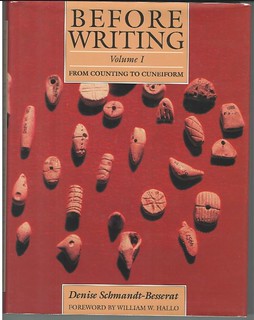

Schmandt-Besserart, Before Writing: From Counting to Cuneiform, 1992
Ridgeway, William, The Origins of Metallic Currency and Weight Standards, 1892
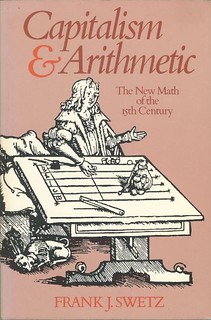

Swetz, Frank, Capitalism & Arithmetic: The New Math of the 15th Century, 1987
George Selgin, Good Money: Birmingham Button Makers, the Royal Mint, and the Beginnings of Modern Coinage, 1775–1821, 2008
To read the complete article, see:
The Future of Money (https://necessaryfacts.blogspot.com/2019/08/the-future-of-money.html)
To access the Google Drive folder, see:
https://drive.google.com/drive/folders/1yJclRPVwgp7pumflxnLoIr2CpEBzZ5rV
To read the earlier E-Sylum article, see:
VIDEO: GARY ADKINS, FUTURE OF NUMISMATICS (https://www.coinbooks.org/v22/esylum_v22n35a10.html)

VIRTUAL HUMANS IN THE FUTURE OF NUMISMATICS?
A vision of the may-be-here-sooner-than-you-think future was presented in a Washington Post article yesterday. Here's an excerpt. There's no numismatic connection, but wouldn't if be interesting to have a conversation with numismatic figures of the past? -Editor
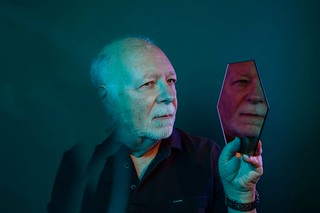 When Andrew Kaplan reminisces, his engrossing tales leave the impression that he’s managed to pack multiple lives into a single existence: globe-trotting war
correspondent in his 20s, a member of the Israeli army who fought in the Six-Day War, successful entrepreneur and, later, the author of numerous spy novels and Hollywood scripts.
Now — as the silver-haired 78-year-old unwinds with his wife of 39 years in a suburban oasis outside Palm Springs — he has realized he would like his loved ones to have access to
those stories, even when he’s no longer alive to share them. Kaplan has agreed to become “AndyBot,” a virtual person who will be immortalized in the cloud for hundreds, perhaps
thousands, of years.
When Andrew Kaplan reminisces, his engrossing tales leave the impression that he’s managed to pack multiple lives into a single existence: globe-trotting war
correspondent in his 20s, a member of the Israeli army who fought in the Six-Day War, successful entrepreneur and, later, the author of numerous spy novels and Hollywood scripts.
Now — as the silver-haired 78-year-old unwinds with his wife of 39 years in a suburban oasis outside Palm Springs — he has realized he would like his loved ones to have access to
those stories, even when he’s no longer alive to share them. Kaplan has agreed to become “AndyBot,” a virtual person who will be immortalized in the cloud for hundreds, perhaps
thousands, of years.
If all goes according to plan, future generations will be able to interact with him using mobile devices or voice computing platforms such as Amazon’s Alexa, asking him questions, eliciting stories and drawing upon a lifetime’s worth of advice long after his physical body is gone.
For decades, Silicon Valley futurists have sought to unchain humanity from the corporeal life cycle, viewing death as yet another transformational problem in need of a “life altering” solution. What began with the cryonics movement, in which bodies are frozen for future resuscitation, has intensified amid the rise of digital culture. Today, a new generation of companies is hawking some approximation of virtual immortality –– the opportunity to preserve one’s legacy online forever.
HereAfter was co-founded by Sonia Talati, who calls herself a personal legacy consultant, and James Vlahos, a California journalist and conversational-AI designer who is best known for creating a software program called the Dadbot. Brought to life after Vlahos learned that his father was dying of cancer, the Dadbot allows him to exchange text and audio messages with a computerized avatar of his late father, conversing about his life as well as hearing songs, small talk and jokes.
Once the Dadbot became widely known, Vlahos received so many requests to create memorializing bots for other people that he decided an untapped market for making virtual people was primed for the mainstream.
“It took my mom two years to remove the answering-machine message with my dad’s voice from their home phone,” Vlahos said. “She didn’t want to extinguish his voice, and that’s something I’ve heard from other people. But it’s almost comical that we’re still relying on such a primitive method to hear the voices of our loved ones after they’re gone.”
I was already aware of the work of James Vlahos from earlier reading, and am not surprised that many people approached him about immortalizing their own loved ones. For years we've only known numismatic figures of the past through their writings and those of others. Video and audio recordings came along, but were widely scattered before the advent of the internet and sites like the Newman Numismatic Portal. This would be a logical next step, to add a degree of interactivity to what we know about those who have gone before us. Interesting concept. -Editor
To read the complete article, see:
‘Hey, Google! Let me talk to my departed father.’
(https://www.washingtonpost.com/technology/2019/08/29/hey-google-let-me-talk-my-departed-father/)
Coincidentally, the weekend Wall Street Journal has an article about "mind uploading", the next step along this futuristic path. -Editor
Imagine a future in which a machine can scan your brain and migrate the essentials of your mind to a computer. It’s called mind uploading—preserving a person’s consciousness in a digital afterlife. As a neuroscientist, I’m convinced that mind uploading will happen someday. There are no laws of physics that stand in the way. It depends, however, on technology that has not yet been invented, so nobody knows when mind uploading might become available.
To read the complete article, see:
Will Your Uploaded Mind Still Be You?
(https://www.wsj.com/articles/will-your-uploaded-mind-still-be-you-11568386410)

VOCABULARY TERM: COPIES AND REPLICAS
Dick Johnson submitted this entry from his Encyclopedia of Coin and Medal Terminology. Thanks! Some great definitions here - I was unaware of some of these distinctions. -Editor
Copies and Replicas. Not the original medallic or numismatic item, but a similar specimen. A wide variety of copies and replicas exist, both authorized and surreptitious, for which a large terminology has developed, including those terms listed here. Copy is a broad term that includes all items not the original; replica, likewise broad, includes all similar items to the original. The terms differ in that copy implies a closer resemblance to the original, replica may be more liberal in its exact replication.
The following criteria determine the precise term: (1) does authorization, approval or legality exist?, (2) intent of maker of the copy? (3) quality of workmanship? (4) use of original or new dies or molds? (5) how is the copy made – cast, struck, electrotype, or other?, and (6) any other diagnostic evidence?
Copies sometimes take on a life of their own and often become a collectible of their own. The Paduan copies of ancient coins, the Bashlow replicas of the U.S. Confederate Cent, the British Museum electrotypes, Bolen and Gallery Mint copies of early American coins, Becker counterfeits. These are all copies, desired by collectors, and infrequently more costly than the originals!
Kinds of Copies
Deluxe Copy – Made with authority for sale to the recipient only in better materials or workmanship than the original (as a decoration prepared in a more precious metal – it was issued in silver, but the recipient may order it made in gold at his own expense).
Custom Copy – Made with authority for sale as a second or subsequent copy (say for a second uniform) or to replace a lost original, or other official use; a custom order usually of one made by original maker and dies. Called replacement medal or sometimes jeweler's copy.
Reissue – Copy made with authority after lapse of time without change from original issue and reuse of original dies to strike a new piece or a new production run.
Revision – Copy made with authority and with a change of design no matter how minute, requiring retooling the original dies or creating entirely new copy dies. Such change might be a new date, new logo, change of sponsor's name, correct a design error, or similar reason.
Replica – Made with authority where a major portion of the previous design is used to make a new coin or medal. Replication is the most common form of copy making. No unauthorized use here, and new dies or molds are used to make the new issue.
Collectors' Copy – Made with authority for sales primarily to collectors or public; these copies are usually electrotypes (as copies sold by museums of specimens in their collections).
Reproduction – Made without authority and reproduced in a new model or composition. A large gray area of legality.
Facsimile – Copy without authority, closely resembling the original and made by any method, as costume jewelry medals.
Private Copy – Made without authority for private use; these copies are usually cast in plaster or metal and if sold may be questionable status (study copies cast in plaster for scientific or scholarly study are certainly legal; private metal copies in off metal are a gray area, but copies the same as the original are outright forgeries).
Imitation – Copy made without authority and technically not illegal; usually of poor quality, or a souvenir status (to be given away), or play money (as child's play copies, or play coins).
Restrike – Copy made without authority from original dies at a later date (and often in deteriorated state, as struck from cracked or rusted dies).
Forgery – Copy made without authority and with intent to deceive.
Counterfeit – Copy made without authority and with intent to deceive and defraud both collectors and the public. Fake and spurious also denote a counterfeit status.
All these terms have one thing in common: the objects are not the original, the first to be made and issued under authority. Another term, a contemporary copy, indicates the time when the replica was made – during the original issuing period (or sometimes during the lifespan of the artist). Contemporary copies of coins are, of course, counterfeits; however a thin line of legality exists if the coin has been demonetized; its counterfeits are subject to numismatic and scholarly study. But counterfeits of ancient coins, made contemporary to their original issue, are now historical objects and legal to own. Replicas of ancient coins made centuries later are forgeries as their maker's intent was to deceive subsequent buyers and collectors.
Cast medals. Cast medals are always suspect of being copies. Because of the ease of reproducing cast specimens it is important data to know the exact diameter of the artist's original mold, or his first casting. Other casts can be made from this original – or subsequent – casts. The term for this is called a generation. In the process of casting, metal shrinks slightly when it cools, each succeeding generation is one to four percent less diameter from the preceding generation. See after-cast, shrinkage.
Novodel. Replicas of older issues of coins, made at the same mint but struck from copy dies are called novodels. The word is derived from the Russian term where mints in Tsarist times made struck copies of early coins and medals as an accommodation for wealthy collectors. It may be a highly technical distinction but if the dies were made from the original hubs we would class this as a reissue; if these were made from copy dies – as we suspect – they would be classed as a revision (see above).
The replication of coins is always suspect; the replication of medals is not always so. We know of museum curators learning of an organization giving an award medal, contacting the organization for permission for a duplicate to be made for the museum's archives. Most of the time this permission was granted and the medal – made by the same manufacturer – ended up in their collections. (Technically this is a custom copy.)
German numismatists use the word abschlag for similar restruck items. Coins normally struck in silver, but restruck from original dies but in gold for presentation purposes are called abschlag. In the above list of terms, an instance of this would be called a deluxe copy.
Test for Authentication
Each suspected copy or replica must stand various tests for authentication. The first such test is for an experienced numismatist to compare the suspect item with a known original specimen. Other than weighing and measuring a specimen, tests employ scientific equipment must be made. The rising need of authentication, authentication service and laboratory testing gives testimony for proving the original status of any given item.
Looking for the meaning of a numismatic word, or the description of a term? Try the Newman Numismatic Portal's Numismatic Dictionary at: https://nnp.wustl.edu/library/dictionary
Or if you would like a printed copy of the complete Encyclopedia, it is available. There are 1,854 terms, on 678 pages, in The Encyclopedia of Coin and Medal Technology. Even running two a week would require more than 19 years to publish them all. If you would like an advance draft of this vital reference work it may be obtained from the author for your check of $50 sent postpaid. Dick Johnson, 139 Thompson Drive, Torrington, CT 06790.

THOMAS JAMES CLARKE (1875-1952)
 Thomas James Clarke (1875-1952), was born on May 7, 1875, at Hastings, Trent Hills, Northumberland County, Ontario, Canada, son of Thomas Borman Clarke (1834-1913), a
carpenter, and Clarissa Sweet Clarke (1840-1916).
Thomas James Clarke (1875-1952), was born on May 7, 1875, at Hastings, Trent Hills, Northumberland County, Ontario, Canada, son of Thomas Borman Clarke (1834-1913), a
carpenter, and Clarissa Sweet Clarke (1840-1916).
His birth information is incorrect published in The Numismatist since the above is taken directly from the original sources in Ontario.
In 1894, twenty-one year old Clarke moved to Batavia, New York, where he worked temporarily as a wheelwright for his uncle John M. Sweet in order to establish himself in America.
The following year in 1895, he began to work as a salesman for E. N. Rowell Paper Box Company until 1900.
In 1900, he founded Clarke-Dorman Drug Box Company. He sold his share of ownership in 1902 to William Koehl. Clarke remained with the William Koehl company until 1916.
On June 26, 1912, he married Hazel Clarabel Johnson (1883-1974), daughter of Olaf Johnson, a tailor, at Chautauqua, New York. They had no issue.
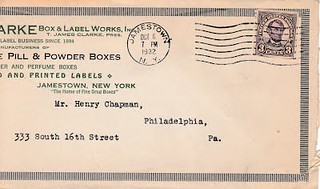 In 1916, he started T. James Clarke Box and Label Works, Inc.
In 1916, he started T. James Clarke Box and Label Works, Inc.
He also served as the Director of the National Chautauqua County Bank, and also for a few other corporations.
Clarke was also quite inventive and held patents on two cabinets marketed to druggists.
T. J. Clarke was an old time traditional collector, i.e., he collected all the wide variety of items and objects typically found in curiosity cabinets. These cabinets were like the Italian use of the word, a whole room. There he kept and arranged autographs, glassware, Indian relics, postage stamps, coins, paper money, and weapons. Clarke is remembered today among the EAC'ers as a buyer of the French collection of large cents. However, colonial notes, old bank notes, and obsolete paper money are also areas from which collectors today trace provenance on many prized pieces.
He was ANA Life Member No. 37. He served as 20th President of the ANA from August 29, 1935, to August 26, 1937.
He sold his entire collection of silver coins to B. Max Mehl in 1939.
In 1944, he exhibited more than 1,000 Lincoln medals.
He died at home in Jamestown, New York, on July 20, 1952.
His paper money collection was sold posthumously at auction by Abe Kosoff November 8, 1955.
Clarke's massive collection of coins were sold in four separate auctions prior to his death, and seven posthumously.
Clarke's boxes were popular with coin collectors for storing coins. The William F. Dunham collection of U.S. Encased Postage stamps is mentioned elsewhere in this issue; each piece in the giant collection had its own T. James Clarke-manufactured box. I acquired the labeled boxes from John J. Ford via Robert Kincaid when Bob and I were working with Fred Reed on EPS research for Reed's book in the 1980s. -Editor
To read the complete article, see:
CLARKE, THOMAS JAMES
(https://sites.google.com/a/numismaticmall.com/www/numismaticmall-com/clarke-thomas-james)
The entire inventory of the Lupia Numismatic Library is for sale. Individual items will be available before the remaining archives are broken up into parcels sold at philatelic auctions in the U. S. and Hong Kong. Check NumismaticMall.com frequently as dozens of new items with estimates will be posted daily until everything is sold.
All inquiries will be given prompt and courteous attention. Write to: john@numismaticmall.com .

MY FIRST COIN CONVENTION BY Q. DAVID BOWERS
Dave Bowers has been working on his autobiography, and this week he published a Stack's Bowers blog article on his first coin convention. -Editor
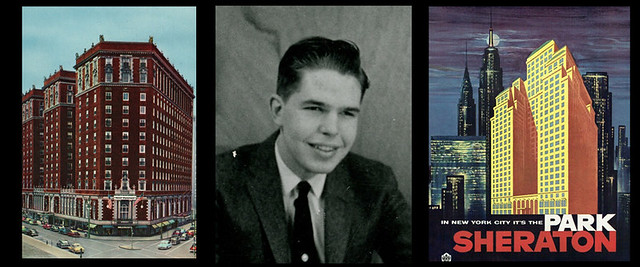
With George Williams I went to an Empire State Numismatic Association (ESNA) convention in Syracuse, New York, in 1954. It was my first regional coin show. By that time I had been a regular attendee at the Wilkes-Barre (Pennsylvania) Coin Club, but had not ventured beyond that. George, a collector of the old school, lived in Kingston, Pennsylvania, adjacent to my home town of Forty Fort. He had been collecting for many years. When I met him he mentioned that Joseph Stack from New York City had come through the area on a buying trip and had offered him the irresistible price of $200 for his Proof 1895 Morgan dollar, and he sold it. (Today the same coin would be worth on the long side of $50,000!). George helped me form a library, answered my endless questions, and each month took me to coin club meetings.
The ESNA show was set up in the lobby of the Syracuse Hotel, with a couple dozen or so dealer tables amidst furniture and with, perhaps, 50 other people buying, selling, and talking about coins. George knew everybody, and I was introduced to Jonah Shapiro, John Jay Pittman, Charles and Arline French, Gaston DiBello, Dr. Kenneth Sartoris, Jacob Cheris, Dr. Fiori F. Pepito, Al Gullian, Kenneth Fuller, Dave Nethaway, Dr. Jasper Robertson, and the other luminaries of Upstate New York coin collecting.
I also met Charles W. Foster, who was nicknamed “Suitcase” Foster, as he carried his inventory that way. He hailed from Rushville, New York, and had been in the hobby for many years. He took a liking to me, and we chatted at length. I reviewed his coins and wrote a check for a nice stock of Uncirculated large cents of the 1816 to 1820 years (which I would later learn were from the Randall Hoard), several prooflike 1795 Talbot, Allum & Lee cents, and a few other things. Even before my dealer discount I thought his prices were wholesale—and if I had been able to, I would have spent much more. I saw him a couple of times after then, and also bought coins from him by mail. He was pointed out by others as being a paragon of professional integrity. Foster died in December 1959, far too soon. Today in 2019 few people remember him.
By that time I had learned that legitimate dealers could be divided into two main classes. The first and most common were those who were in it for the money—no pun intended—and bought and sold coins strictly as a business. They could just have easily been selling watches or sacks of potatoes. As a kid I would be brushed off quickly by them, unless I showed interest in something expensive.
The second category of dealers embraced Jim Ruddy, “Suitcase” Foster, John J. Ford, Jr., Harvey and Morton Stack, Maurice Gould and Frank Washburn of the Copley Coin Co., and a few others: they loved coins and their history and really enjoyed sharing information with other “coin people.” Just talking about numismatics was enjoyable and an important part of their lives.
After the NENA show I attended several others, the most important being the Metropolitan New York convention held in the Park Sheraton Hotel a short walk from Stack’s. I was an eager buyer and an enthusiastic seller. By that time I had several hundred customers who bought from me by mail. Most became friends and remained with me for many years.
Armed with information I had learned from books on colonial coins, patterns, and other things I made a lot of unearned, so to speak, profits at coin shows by purchasing coins from dealers who did not realize they had rare varieties. This was fair and square, as I paid the prices asked, less a dealer’s discount, and the sellers were quite happy. Indeed, for colonial and early American coins they were usually delighted, for they had very few customers for these; the specialty was not popular at the time. On the other hand, if a collector showed me a coin and asked me to make an offer, I would quote a price reflecting the rarity of the variety even if the owner was not aware of it. I tried to treat others as I would like to be treated by them. This philosophy, still in effect, has worked well over the years.
To read the complete article, see:
My First Coin Convention
(https://www.stacksbowers.com/News/Pages/Blogs.aspx?ArticleID=first-coin-show-qdb)

MINT OFFICIAL JON CAMERON SIGNS NGC LABELS
E-Sylum readers may recall that I had the chance to meet former U.S. Mint official Jon Cameron in July. There's a nice bio of him in this September 11, 2019 press release from Numismatic Guaranty Corporation. -Editor
 Jon J. Cameron's 41 years of civil service also included time as an executive with the Bureau of Engraving and Printing and the Federal Reserve System.
Jon J. Cameron's 41 years of civil service also included time as an executive with the Bureau of Engraving and Printing and the Federal Reserve System.
Jon J. Cameron, who recently retired from his position as the US Mint’s Associate Director of Numismatic, Bullion and Coin Studies, has agreed to autograph certification labels exclusively for Numismatic Guaranty Corporation® (NGC®).
Cameron spent 41 years in federal service. He joined the US Mint in 2013, where his first job was to establish and serve as Director of the Office of Coin Studies, which monitored trends in the use of cash, emerging payment technologies, research into alternative metals and trends and policies of other nations’ mints.
He added the responsibilities of leading Numismatic, Bullion and Coin Studies in 2015. From that time until his retirement in May 2018 Cameron was deeply involved in the production of many of the US Mint’s most popular coins, including:
the American Silver, Gold and Platinum Eagles; the first US Mint palladium coin, the 2017 High Relief American Palladium Eagle; the American Gold Buffalo; the 2016-W Gold Mercury Dime, Standing Liberty Quarter and Walking Liberty Half Dollar; the 2017 US Mint 225th Anniversary Gold $100 and Silver Medal; and, the US Commemorative Coin Series. Cameron’s currency-related career dates to 1972, when he went to work for the Federal Reserve Bank of Richmond. Cameron spent 34 years with the Federal Reserve System where, as a senior manager, he gained experience in cash operations, internal controls, anticounterfeiting, new currency designs and public education. He also was Director of the International Currency Awareness Program — a task force of the Mint, Treasury Department, Federal Reserve and Secret Service that studied how US currency is used abroad as well as the extent of counterfeiting outside the United States.
In 2006, he became Associate Director of the Bureau of Engraving and Printing’s Eastern Currency Facility in Washington, DC.
“I spent 41 years working to safeguard the quality and integrity of US coins and currency,” Cameron said. “I am excited to now work with NGC, which shares a similar mission by providing its expert services to coin collectors with a strong commitment to quality and integrity.”
“Jon Cameron is an ideal fit for our industry-leading Authentic Hand-Signed Labels program,” said Mark Salzberg, NGC Chairman and Grading Finalizer. “He has played a key role in many of the most interesting and popular US coins of the last decade.”
Cameron now does consulting work as CEO of Cameron Associates LLC.
NGC Authentic Hand-Signed Labels pair an influential person's autograph with a coin to create a one-of-a-kind collectible. The roster of people who have signed NGC labels includes Elizabeth Jones, the 11th US Mint Chief Engraver; former US Mint Director Edmund C. Moy; and John Herrington, the first person enrolled in a Native American tribe to go into space.
NGC Jon Cameron Authentic Hand-Signed Labels will be available soon from select retailers.
To learn more about NGC Authentic Hand-Signed Labels, visit NGCcoin.com/SignatureLabels.
To read the complete article, see:
Veteran US Mint Official Jon Cameron Joins NGC Program of Hand-Signed Labels
(https://www.ngccoin.com/news/article/7716/)

Former U.S. Mint Officials Dick Peterson, Jon Cameron
To read the earlier E-Sylum article, see:
WAYNE'S NUMISMATIC DIARY: JULY 21, 2019 (https://www.coinbooks.org/v22/esylum_v22n29a20.html)

LITTLETON COIN COMPANY NEEDS WORKERS
Dave Bowers passed along this article from the New Hampshire Union-Leader involving one of his favorite dealerships, Littleton Coin Company. Thanks! -Editor
 During Thursday’s inaugural Community Open House, businesses in the Littleton Industrial Park said they’re thriving but in significant need of more employees.
During Thursday’s inaugural Community Open House, businesses in the Littleton Industrial Park said they’re thriving but in significant need of more employees.
Home to 18 businesses — which cumulatively employ more than 1,200 people — the 380-acre industrial park is a North Country success story whose future is dependent on filling scores of existing and expected job vacancies.
To address what they believe is a universal concern within the industrial park, management at the Littleton Coin Co. came up with the idea of inviting the community inside, not just to fill immediate openings, but to see what makes their companies tick and great places to work now or in the future.
Joining the company in the Open House were Genfoot America Inc., New England Wire Technologies, Schwan’s Sales Enterprises, Secured Network Services and Tender Corp.
“Like the other companies (in the industrial park), we’re struggling to find qualified employees,” said Carol Stevens, who is the Littleton Coin Co.’s human resources director, “and we wanted to tell our story’”
The Open House let the company do both, she said, and it might also generate some job applications.
Poised on the cusp of its 75th anniversary, which it will celebrate in 2020, the Littleton Coin Co. has 270 employees, nearly all of them full-time, said Stevens. She said the average employee at the company, which became 100 percent employee owned on Jan. 1, 2017, has worked there 11.3 years on average, while its longest serving employee has 47 years on the job.
The company’s call center handles 300,000 incoming calls a year, and it is currently down 10 workers, said Stevens, while several more are required elsewhere.
With onsite Pilates and yoga classes and programs about estate planning, the Littleton Coin Co. is dedicated to its employee-owners, said Stevens.
“I’m very proud that employees cross departmental lines frequently,” Stevens said, adding that “80 percent of openings are filled internally.”
Stevens thinks the industrial park will host open houses more frequently, including next spring to appeal to recent high-school and college graduates.
To read the complete article, see:
Littleton Industrial
Park businesses need more workers
(https://www.unionleader.com/news/business/littleton-industrial-park-businesses-need-more-workers/article_12e06964-0174-57fa-a710-6d3d0e980073.html)
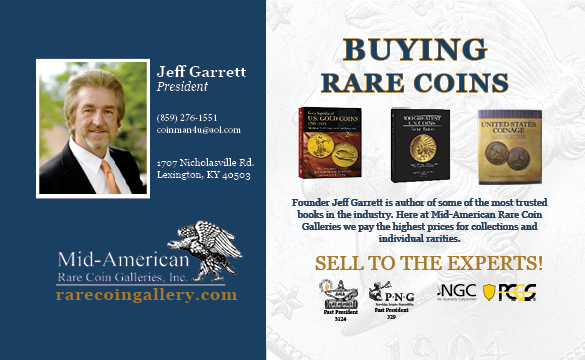
TRASK FAMILY YN SUMMER SEMINAR SCHOLARSHIP
The Civil War Token Society is sponsoring a Summer Seminar scholarship for young numismatists. Here's how to apply. -Editor
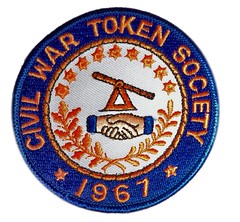 In recognition of Susan Trask and her husband the late Frank Trask, the Civil War Token Society has created the annual Trask Family YN Summer Seminar Scholarship for
young numismatists to apply for financial assistance to cover the cost of tuition, room, and board charged by the American Numismatic Association.
In recognition of Susan Trask and her husband the late Frank Trask, the Civil War Token Society has created the annual Trask Family YN Summer Seminar Scholarship for
young numismatists to apply for financial assistance to cover the cost of tuition, room, and board charged by the American Numismatic Association.
Susan and Frank Trask have been instrumental in supporting education and outreach in the collecting of Civil War tokens; pushing the envelope and inspiring great numismatists. Applicants should be excited about the hobby and eager to contribute to its growth.
How to Apply:
Applicants must submit a written request to the scholarship committee chair, post marked by the 1st of February, the calendar year of the upcoming Summer Seminar. The awarded
recipient must produce a self-directed project using the skills acquired from the Summer Seminar.
Examples may include but are not limited to:
• a published article in The Civil War Token Journal
• publishing online research, commentary, or collecting notes on Civil War tokens
• a local presentation to a historical society or school group
Fine Details:
Applicants must be Civil War Token Society members or pending membership at the time of application. The award is not guaranteed on an annual basis and is subject to the
scholarship committee review, composed of Civil War Token Society Board of Governors members.
Submissions to:
Cole Hendrickson (Commission Chair)
P.O. Box 5741
Scottsdale, AZ 85261
hendcol3@hotmail.com
For more information on the Civil War Token Society, see:
http://www.cwtsociety.com/

MEDIALIA GALLERY FALL 2019 EXHIBITS
Medialia Gallery in New York has mounted three new exhibits of medals. -Editor

Space I
September 14 – November 23, 2019
PROGRESSION:
Medallic art by Japanese artists
and Portugal’s ANVERSO REVERSO
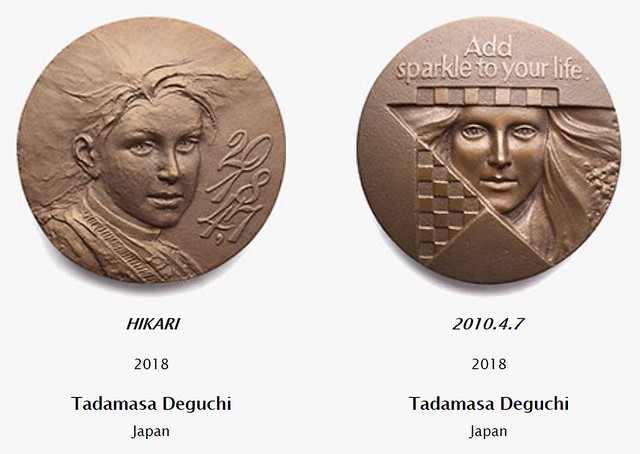
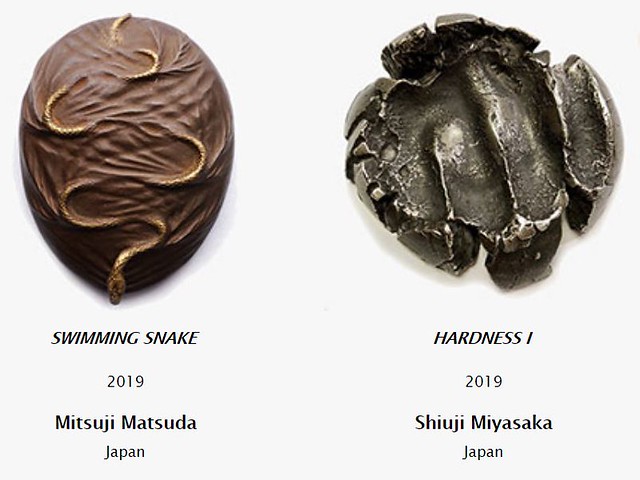
JAPAN: Yasafumi Chuma, Tadamasa Deguchi, Yumi Inoue, Naoko Ito, Masaharu Kakitsubo, Kasuke Kishi, Kimiharu Kitamura, Shunsuke Komatsu, Mitsuji Matsuda, Shiuji Miyasaka, Keiichi Murata, Noriko Ogino, Mitsuho Shibata, Akemi Shuno, Hiroko Suizu, Masato Tagami, Masayuki Takemoto, Tsutomu Tamura, Haruya Tsumoto, Yutaka Umezawa, Tomohiko Yamada, Toshiaki Yamada, Yayoi Yokoyama, Kazuo Yoshida, Michael Reed (New Zealand) PORTUGAL: Helder Batista, José João Brito, Antonio Canau, João Duarte, Maria João Ferreira, Andreia Pereira, Vitor Santos, José Simão, José Teixeira
Space II
September 14 – October 26, 2019
Marion Held
HEEDLESS OF TIME
sculpture, wall hangings, and dresses
Space III
Through July 2020
New Approach Contemporary Medallic Art Research Center
American Medalists in Paris

Curated by Scott Miller from the collections of: Jay Galst, Scott Miller, Ira Rezak, David Simpson, Donald Scarinci, Frederic Withington
To visit the gallery web site, see:
http://www.medialiagallery.com/
THE BOOK BAZARRE
MEL WACKS COLLECTION OF ANCIENT JUDAEAN COINS
This press release from Goldberg Auctioneers describes highlights from the Mel Wacks Collection of Ancient Judaean and Related Coins, being sold by Goldberg Auctioneers. -Editor
Coins to be Sold by Goldberg Auctioneers at the Upcoming New York
International Numismatic Convention, January 14-16, 2020
Like the ad slogan: "You never actually own a Patek Philippe. You merely look after it for the next generation," Mel Wacks has indicated that he has gained great satisfaction in owning 2,000 year-old Judaean and related coins for over 50 years – and now it is time to pass them along to the next generation. Mel goes on to say that “There is nothing quite as thrilling as holding a coin in your hand that could have been used by the fighters for Judaean independence in the Maccabean uprising, or during the First or Second Judaean Revolts. Even the Roman coins inscribed ‘Judaea’ or a variant thereof are proof that this was the ancient Jewish homeland.”
The following coins are among those that will be featured by Goldberg Auctioneers at the Upcoming New York International Numismatic Convention, January 14-16, 2020. The historical backgrounds have been taken largely from Mel Wacks’ Handbook of Biblical Numismatics, which is available free at www.amuseum.org/book. All of the coins in the Mel Wacks Collection, and other lots can eventually be viewed and bid on at www.goldbergcoins.com. You can get the printed catalog free by calling 800-978-2646 or emailing ira@goldbergcoins.com, and mention that you read about this sale in E-Sylum.


When the Jewish Revolt broke out in 66 CE, the revolutionaries quickly captured the holy city of Jerusalem, thus assuring them access to the great Temple for religious purposes and to its vast treasury as well. From the silver therein - presumably consisting of Tyrian coins paid in taxes over the years - they struck the most famous of all Jewish coins - in shekel and half shekel denominations. These handsome coins are the first truly Jewish silver coins. They feature a chalice on one side with the year of the revolt above, surrounded by the ancient Hebrew inscription "Shekel of Israel." Three budding pomegranates are featured on the reverse, with the inscription "Jerusalem the Holy."
Purchased from Hans Schulman Auction, 5/5/63.

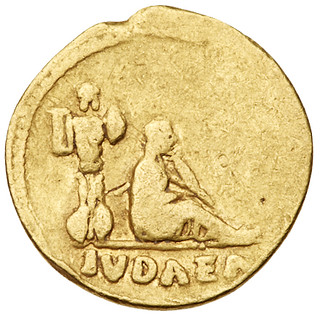
Soon after the Temple at Jerusalem was razed by the victorious troops led by Titus in 70 CE, his father - Emperor Vespasian - launched an extensive issue of coins commemorating the hard fought Roman victory over the tiny Jewish nation. The design elements of this gold aureus are a palm tree and a seated figure of a female (allegorical representative of Judaea) in an attitude of mourning. The depiction on this coin may reflect the prophesy of Isaiah (c. 700 BCE): "For Jerusalem is ruined, and Judah is fallen ... Thy men shall fall by the sword and thy mighty in the war. And her gates shall lament and mourn, and she being desolate shall sit upon the ground" (Isaiah 3:8, 25-26).
Purchased from Jacques Schulman, date unknown.
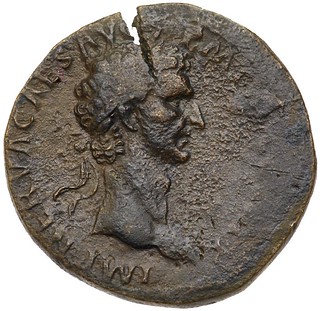

In 70 CE, after the fall of Jerusalem, many thousands of Jews were taken to Rome as slaves and others were exiled from Judaea. Rome took over the collection of the annual Jewish head tax, which had been a half shekel (equivalent to two Roman denarii). The Romans collected this tax with much zeal ... so much so that it caused embarrassment to Jews and non-Jews alike.
Following the reign of Domitian, came the short but liberalizing rule of Nerva (96-98 CE). One of the first reforms he instituted concerned the department (Fiscus Judaicus) responsible for the collection of the Jewish head tax. In her paper “The Interpretation and Wider Context of Nerva’s Fiscus Judaicus Sestertius, Marius Heemstra came to the conclusion that “Nerva’s coin … is very plausibly evidence that the new emperor no longer permitted people to be accused of living a Jewish life. This specific accusation became a ‘wrongful accusation’ (calumnia). Towards the end of [his predecessor] Domitian’s reign, high-ranking Romans accused of ‘living a Jewish life’ could have their property confiscated and they could even end up being executed.
A large bronze sestertius was issued to commemorate this reform. This scarce coin features a palm tree, that had become symbolic of the Jewish people on the Judaea Capta coins, and the Latin inscriptions "FISCI IVDAICI CALVMNIA SVBLATA" (the calumny of the Jewish tax is removed) and "S C" (by consent of the Senate).
Purchased from Tom Donner, 8/66.

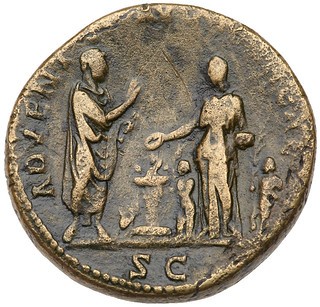
The Roman Emperor Hadrian (117-138 CE) visited many of the Roman provinces, including Judaea in 130 CE. Immediately, the rumor spread among the Jewish inhabitants that the Emperor, one of the great ancient builders, intended to rebuild the Jewish Temple in Jerusalem. He did intend to build a temple on this holy site ... however it was to be a pagan Roman temple dedicated to the god Jupiter (Zeus). Leo Kadman writes: "The Jews watched the stones of the Sanctuary being used to erect temples for heathen gods. No choice was left to them but to interrupt the building of the Roman colony by force of arms before it was completed" (The Coins of Aelia Capitolina).
At the age of 60, Hadrian returned to Rome from his travels, and began to strike coins to commemorate his visits to the empire’s provinces-- Egypt, Macedonia, Spain, etc.--and the Judaean visit was no exception. His ADVENTVI AVG IVDAEA bronze sestertius, issued sometime between 134 and 138 CE, shows the Emperor receiving a Jewish woman and two children who carry palm branches; in the background, a bull appears next to a sacrificial altar. (#95) The altar was a reference to the god Jupiter Capitolinus, to whom Hadrian had dedicated his new pagan temple. Hadrian renamed Jerusalem as Aelia (his family name) Capitolina.
Purchased from Christian Blom, 3/73.


The overstruck silver tetradrachms (called "sela" in the Mishnah) are among the most religiously significant coins issued by the ancient Jews, since the Holy of Holies of the Jerusalem Temple is depicted, along with the Ark - that had held the two tablets of the Ten Commandments in Solomon's time. Beginning in the second year and continuing into the final year, a star appeared above the Temple on many coins, likely alluding to Bar Kochba's nickname "Son of the Star." During the third year of the revolt, "For the Freedom of Jerusalem" was inscribed around the Temple.
Purchased from Bank Leu Auction, 12/7/66.
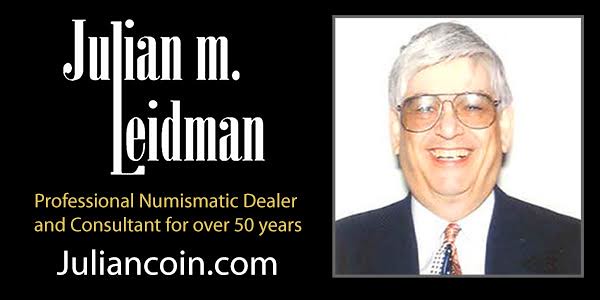
NUMISMATIC NUGGETS: SEPTEMBER 15, 2019
Here's a selection of interesting or unusual items I came across in the marketplace this week. Tell us what you think of some of these. -Editor
Bernini Medal of Pope Alexandar VII Chigi


Gian Lorenzo Bernini
Medal of Pope Alexandar VII Chigi
Mid-17th Century
Italian sculptor, painter, and architect, Gian Lorenzo Bernini, designed this bronze portrait medallion commemorating Pope Alexandar VII Chigi, who served as the Pope from 7 April 1655 to his death in 1667. Alexander was interested in architecture and supported various urban projects in Rome. He also wrote poetry and patronized artists who expanded the decoration of churches, which is probably how he came to know and commission Bernini to design his medal. One side of the round medal reveals his portrait in profile, while the other features the legend of Androclus and the Lion at the moment the lion suddenly cowers and spares the life of a condemned slave who once pulled a thorn from its foot. The cowering lion symbolizes Rome’s thankful remembrance of the pope’s courageous leadership during the plague of 1656-1657; an inscription on a scroll proclaims “The beast, too, remembers the kindness”.
I didn't know Bernini was a medallist. From Sotheby's. -Editor
To read the complete lot description, see:
Gian Lorenzo Bernini Medal of Pope Alexandar VII Chigi Mid-17th
Century (https://sothebyshome.com/gian-lorenzo-bernini-medal-of-pope-alexandar-vii-chigi-acc-59602-40030.html)
1909 Spanish Commemorative Medal


[UNATTRIBUTED] BRONZE COMMEMORATIVE MEDAL : ESPOSIZONE NAZIONALE ESTIVA LIVORNO, 1909.
South America
Commemorative medal : Esposizone Nazionale Estiva Livorno, 1909
Bronze
2-1/4 inches
Unsigned.
Excellent condition.
Not the best medal I've seen, but the obverse is interesting. -Editor
To read the complete lot description, see:
[UNATTRIBUTED] BRONZE COMMEMORATIVE MEDAL : ESPOSIZONE
NAZIONALE ESTIVA LIVORNO, 1909. (http://davidsmernoff.com/product/unattributed-bronze-commemorative-medal-esposizone-nazionale-estiva-livorno-1909/)
Gerald Ford Inaugural Medal Set

Gerald Ford: Cased Set of Inaugural Medals.
Cased set of official inaugural medals produced by Danbury Mint, including 24kt gold on pure silver, pure silver in proof finish, pure silver in antique finish and solid bronze.
Sold with accompanying literature/sales sheet from Danbury Mint from time of issue.
Over at Heritage there's this set of four Gerald Ford inaugural medals, including a gold. -Editor
To read the complete lot description, see:
Gerald Ford: Cased Set of Inaugural Medals..
... (https://historical.ha.com/itm/political/inaugural-1789-present-/gerald-ford-cased-set-of-inaugural-medals/a/6191-43856.s)
Love Token Greeting Cards
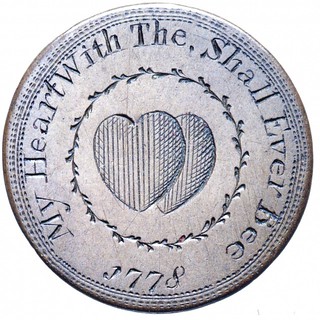

Remember this for Valentine's Day. Dealer Timothy Millet is offering greeting cards with illustrations of early love tokens. Cool. -Editor
To read the complete items descriptions, see:
Love Token, My Heart with Thee Shall Ever Bee (https://www.historicmedals.com/viewItem.php?no=4120)
Blow Me a Kiss, Love Token Greeting Card (https://www.historicmedals.com/viewItem.php?no=3359)
SIDEWALK FIND: SYRACUSE DEKADRACHM
It must have been a slow news day in Traverse City, MI. The Record-Eagle published a story about a man's sidewalk find of what looks like a Syracuse Dekadrachm. The crazy possible value estimates are just what Jeff Garrett discussed in his article last week. But a local dealer set everyone straight with an excellent no-nonsense response. -Editor
A coin found on a sidewalk in Traverse City could be worth thousands of dollars if it is the genuine article.
Traverse City Police Sergeant Matt Richmond said dispatch received a call Wednesday that someone had found a coin on the sidewalk along Eighth Street near a construction site. The person said the coin looked valuable.
Although detectives have not yet determined exactly what coin it is, Richmond conducted an image search online and found that it is possibly a Syracuse Dekadrachm, an ancient Roman coin that was in circulation between 405-380 B.C.
A worn Syracuse Dekadrachm can fetch the owner about $3,000 if it is authentic, according to CoinQuest. The average circulated Syracuse Dekadrachm is worth about $4,000 while a well-preserved version of the coin is valued at $6,000. Other versions have been bought for far more at auction, including one for $437,000 in 2013 and another for more than $340,000 in 2014, according to Coin Week.
The odds of this particular coin being the real deal aren’t great, said Steven Garvin, owner and operator of Honor Coin & Stamp in Traverse City. Garvin, without having seen the coin, estimated there is a 25 percent chance it is a true ancient coin.
“I guess it’s possible,” Garvin said, “but I have a box behind my desk that says ‘NFG’ on it. Stands for ‘No ----- — good.’ There’s a lot of stuff in there, and those ancients are a lot of the stuff you see that’s no good.”
Richmond said the police department will keep the coin in evidence. If it is not claimed within six months, the person who found it can claim it. If that person does not claim it, Richmond said the coin is likely to be destroyed.
To read the complete article, see:
Police: Possible rare coin found
(https://www.record-eagle.com/news/police-possible-rare-coin-found/article_227a8934-d571-11e9-9d65-1bdab84090ac.html)
To read the earlier E-Sylum article, see:
LOOSE CHANGE: SEPTEMBER 8, 2019 : What to Do with Inherited Coins
(https://www.coinbooks.org/v22/esylum_v22n36a31.html)
LOOSE CHANGE: SEPTEMBER 15, 2019
Here are some additional items in the media this week that may be of interest. -Editor
Solid Gold Toilet Stolen
Remember the giant gold coin stolen from a Museum in Germany? An artist created a solid gold toilet which was installed for an exhibition at England's Blenheim Palace. Yeah, it was stolen. -Editor

British police have arrested a 66-year-old man in connection with the theft of a solid gold toilet from a palace west of London.
The toilet, titled America, is a work of art by the 58-year-old Italian artist Maurizio Cattelan. It had been installed for an exhibition at England's Blenheim Palace earlier this week.
The toilet — worth, by some estimates, up to $1.25 million — was connected to the plumbing of the building. As a result, its removal caused extensive damage. Blenheim Palace, a UNESCO World Heritage Site and the birthplace of Winston Churchill, announced Saturday that it would be closed for the day.
The fact that America could actually function as a toilet was key to its message. It had previously been on display at the Guggenheim in New York, where it replaced the standard toilet in a small, single-unit museum restroom.
Michelangelo's David it's not, but it would have gone well with Steve Martin's fur sink... -Editor
To read the complete article, see:
British Authorities Scramble To Find Stolen Solid Gold
Toilet (https://www.npr.org/2019/09/14/760822076/british-authorities-are-scrambling-to-find-a-stolen-solid-gold-toilet)
DIRTY MONEY RESEARCH WINS IG NOBEL AWARD
Tom Sheehan passed along the latest Ig Nobel Award, this time for a study on the Yuckiest money. Thanks. -Editor
 The search for the banknote most likely to pass on infectious diseases has resulted in the Ig Nobel prize for economics for Dutch and Turkish scientists.
The search for the banknote most likely to pass on infectious diseases has resulted in the Ig Nobel prize for economics for Dutch and Turkish scientists.
The Ig Noble prizes, awarded for offbeat scientific discoveries, are meant to make people laugh, then think and were awarded for the 29th time at Harvard University on Thursday evening.
Microbiologist and infection prevention expert Andreas Voss, his son Timothy and Turkish scientist Habip Gedik shared the economics prize for discovering that Romanian bank notes are the most susceptible to picking up germs.
Voss stumbled on the idea of banknote research during a trip to China while fingering a pile of dirty banknotes, he told the NRC. Together with Gedik and his son, he decided to compare the hygiene of euros, Indian rupees, Croatian kunas, American dollars ‘and a handful of other currencies left in a drawer’, Voss told the paper.
Voss and his team sterilised the banknotes, then infected them with three resistant bacterial strains, including MRSA and E.coli. After two hours they checked which had survived. In a second experiment the infected notes handled by people to measure transfer.
Rumanian Leu banknotes looked the filthiest and were the filthiest, the research showed. ‘All the strains survived and ended up on the hands of the tellers. The rupee and the kuna felt dirty but weren’t. ‘Grimy looking banknotes are not always sources for infection,’ Voss told the paper.
The E.coli strain survived on the euro but didn’t end up on the tellers’ hands. The American dollar, Voss said, was the banknote that struck him as one of the dirtiest of all, because it looked clean and crisp but turned out to be a good environment for MRSA.
Voss thinks the paper used influences bacterial survival. ‘I have been contacted by banks about the right sort of paper but that is not something covered by the research,’ he said.
The whimsical nature of the award is something Voss thinks works well with his attempts at getting a serious message across. ‘The prize is up my street. I always try to use humour to explain that micro-organisms are all around us and that we need to wash our hands after going to the toilet. I myself am among the measly 15% that does,’ the paper quotes him as saying.
The Ig Noble prize is a Zimbabwean banknote for (a clean) ten billion dollars. Other winners included research into the scrotum temperature of naked and dressed French postmen, while Italian scientists found that pizza is healthy as long it is made and eaten in Italy.
"Dirty money" studies like these come up so often I don't always bother commenting on them. My thought on seeing this was, "What, ANOTHER one?" By itself it's a fine study, but why do we need so many of them? Don't they research these before they start their work? -Editor
To read the complete article, see:
How clean is cash? Dutch research into filthy lucre wins Ig
Nobel (https://www.dutchnews.nl/news/2019/09/how-clean-is-cash-dutch-research-into-filthy-lucre-wins-ig-nobel/)
FEATURED WEB SITE: ERROR-REF.COM
This week's Featured Web Site is the Error – Variety Ready Reference created by Mike Diamond, Fred Weinberg, Jon Sullivan and others.
Error-ref.com is a comprehensive illustrated glossary of every conceivable defect associated with the minting process. It will contain detailed illustrated descriptions of hundreds of basic error types, numerous subtypes, and assorted effects associated with them. It is not designed to cover compound errors and multiple errors, as these occur in an infinite number of combinations and permutations. It is also not intended to be a catalog of specific coins and dies.
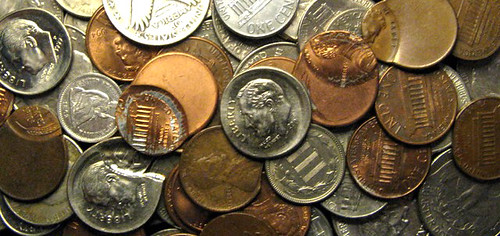
http://www.error-ref.com/

